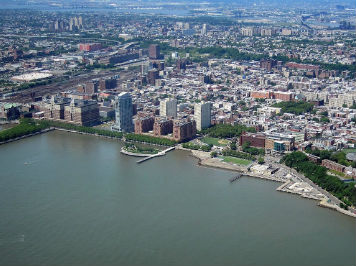Among NY Waterway’s bogus talking points is that a park at Union Dry Dock would be a burden on Hoboken taxpayers and that Hoboken doesn’t need any more parks.
The concept of a linear park at Hoboken’s riverfront began in 1990 when the city had one of the lowest per capita open space ratios in the state of New Jersey. Over the past 30 years, the land for this park has been secured and the park has been built one segment at a time. Both the City of Hoboken and private developers have procured the necessary funds, totaling tens of millions of dollars, to make this concept a reality for much of the mile and a half fronting the Hudson River. Very few municipal tax levy dollars have been used to construct this park.
In the 1990s, the Port Authority of New York & New Jersey provided the funds to build the award-winning park at Hoboken’s South Waterfront as well as the public streets. Funding for the maintenance of this park is provided by a dedicated revenue stream generated by the three blocks of new development at the South Waterfront.
Most of the other funding to build this waterfront park system has come from from a series of state or federal grants. The first was Sinatra Park built in the 1990s with funding from the state’s Green Acres program. The City arranged for a 50-year lease with Stevens Institute to create Castle Point Park that runs from 7th to 9th Streets and built with state and federal monies.
Both Maxwell Place Park and the Shipyard public walkway & piers were funded through generous USDOT grants. Stevens Institute built the walkway that connects Sinatra Park to Castle Point Park by securing two grants, one from the USDOT and the other from the federal American Resource & Recovery Act. The funding for the walkway at the Weehawken Cove came from the Hudson County Open Space Trust Fund and yet another USDOT grant.
The Hudson River Rebuild by Design project has developed a design for a park at the Weehawken Cove that makes it part of the project’s “resist” strategy to protect against future storm surges. The construction of this park should be paid out of the $230 million grant for this federally funded project and will likely be the next portion of Hoboken’s waterfront park to be completed.
The only municipal dollars spent for park construction was for Pier C Park, a 5% contribution to the total cost that came primarily from Port Authority funding.
In 2001, the original developers of Maxwell Place agreed to donate four acres on the river-side of Sinatra Drive North for a public park, working in conjunction with FBW. This agreement included a revenue stream from this development project to pay for the maintenance of the park. The Shipyard Project and the Toll Brothers development at the Weehawken Cove, as part of their waterfront permit agreements with the State of New Jersey, required these projects to pay for the maintenance of the public space provided at the piers and waterfront walkway.
In November 2007 by a 10 to 1 margin, the voters of Hoboken approved the Open Space Trust Fund. The following January, the Hoboken City Council adopted this ordinance that established a dedicated revenue stream to fund the acquisition and construction of parks. In 2011, the Council approved a bond ordinance appropriating $20 million for acquisition of open space. The annual revenue from the Open Space Trust Fund can be used to pay off this bond.
In April of 2018, the City of Hoboken initiated eminent domain proceedings to acquire Union Dry Dock from NY Waterway, doing business as Port Imperial Marine Facilities, LLC. The City made an offer to acquire the site at fair market value, having determined that funds were available from the 2011 bond and the Open Space Trust Fund. After the Governor intervened, the City withdrew its eminent domain ordinance in exchange for a commitment from Governor Murphy to study alternate sites for a ferry maintenance facility. In the year since, the Governor has not held up his end of the bargain.
There are other creative approaches that the City can take to fund the building of a 3-acre park at Union Dry Dock, thus avoiding any additional local tax burden. The many redevelopment plans approved by the City of Hoboken could include developer agreements that would provide funding for park construction. As the population of Hoboken continues to grow, the demand for public open space does as well.
Currently, there are only .68 acres of park for every 1,000 Hoboken residents. This is well below New York City’s standard of 2.5 acres and the national standard of 6.25 to 10.5 acres of parkland per 1,000 residents. As residential and commercial development continues at a healthy pace in Hoboken, the opportunities to add open space are rapidly disappearing. Completing the waterfront park at the former Union Dry Dock site would add over 3 acres of public parkland – a 10% increase in Hoboken’s public open space inventory – and provide a critical link from Castle Point Park to Maxwell Place Park. As evidenced by the remarkable success of New York City’s Highline, a fully connected, undeniably public park along Hoboken’s waterfront from end to end would make Hoboken a model for other waterfront communities in providing open green space that will benefit the public for generations to come.



